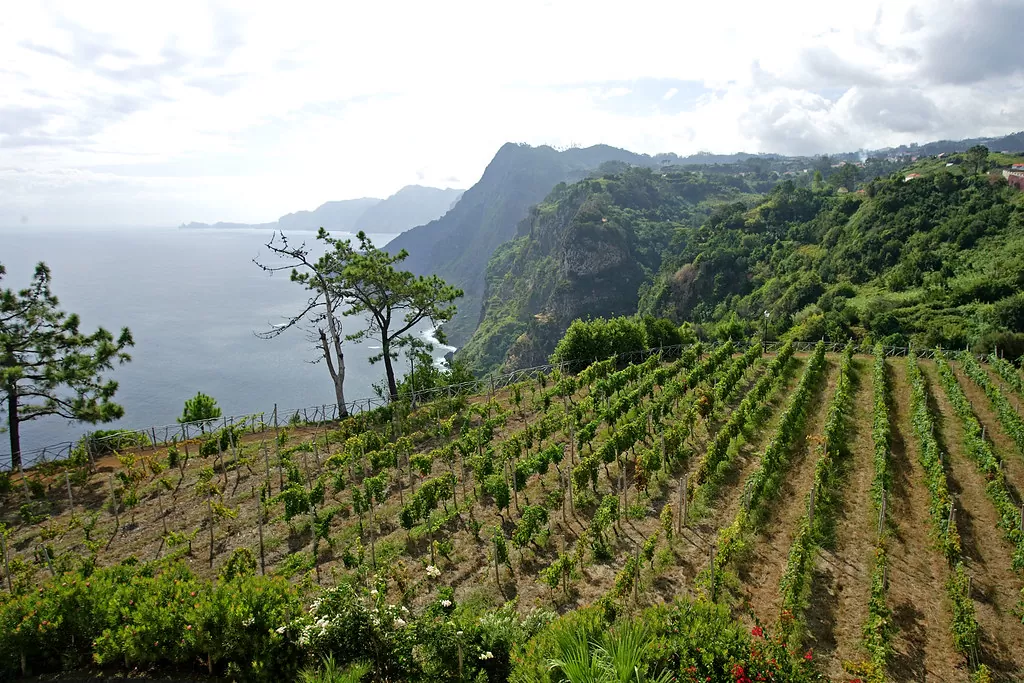Located off the coast of Portugal, the island of Madeira offers a unique vineyard. This volcanic land produces powerful, complex and long-lasting wines. Madeira wines are among Portugal's finest, renowned for their longevity and inimitable aromatic profile.
If you're interested in wine-related articles, download our app for IOS or Android. It will give you access to our wine lexicon, our articles and our innovative solution, designed for all wine consumers and collectors.
A vineyard on a mountainside
Madeira's vines grow on steep, terraced slopes. The volcanic, mineral-rich soil lends great tension to the wines. Altitude varies, directly influencing the style of each cuvée. At higher altitudes, the wines are more acidic and fresher. Lower down, the grapes develop riper, rounder aromas.
The subtropical climate also imposes constraints. Rain is frequent, but well distributed. Thanks to an ingenious irrigation system called levadas, the vines receive the water they need all year round.
A winemaking process unique in the world
Madeira wines are unlike any other. After fermentation, they are fortified with wine alcohol. Then they undergo a thermal aging process called estufagem or canteiro. This process heats the wine slowly, sometimes for several years. This technique enhances concentration and stabilizes the wine.
Thanks to this treatment, Portuguese Madeira wines can age for over a century. They develop complex notes of dried fruit, spices, caramel and nuts. Their natural acidity balances the richness of sugar and alcohol.
Madeira's great grape varieties

Four grape varieties dominate production. Each produces a wine with a unique profile. Madeira Island grape varieties reflect the aromatic diversity and finesse of the terroir.
Sercial produces dry, crisp wines. Their freshness combines with notes of citrus, almond and salt. They are ideal as aperitifs or with seafood.
Verdelho offers semi-dry wines. They are rounder, with aromas of yellow fruit, hazelnut and light tobacco. They go well with mature cheeses and sweet-savory dishes.
Boal (or Bual) produces mellow, generous wines. They release fragrances of figs, dates, coffee and toast. Ideal with desserts or foie gras.
Malmsey (or Malvasia) produces the sweetest wines. Their full-bodied palate reveals flavors of caramel, chocolate, candied orange and nutmeg. These are meditative wines, perfect after a meal.
Madeira wines classified by style
There are different categories depending on the length of aging. Reserve wines age between 5 and 10 years. Special Reserve wines age between 10 and 15 years. Extra Reserve between 15 and 20 years. Finally, Colheita (vintage wines) and Frasqueira (exceptional wines for laying down) mature for more than 20 years.
Each level brings greater depth, complexity and length on the palate. Madeira wines gain in nobility with age. They retain their freshness thanks to exceptional acidity, even after several decades.
Emblematic houses to discover
Several historic producers still dominate the market. These companies perpetuate their unique know-how, while modernizing certain stages of the winemaking process.
Blandy's remains one of the best-known names. It offers a wide range of wines, from entry-level to great vintages. Its historic cellar in Funchal can be visited all year round.
Henriques & Henriques excels in off-dry and sweet styles. It has perfect mastery of long ageing and oxidation management. Its Malmsey cuvées are among the richest on the market.
Barbeito represents the new generation. It focuses on elegance, finesse and innovation. Its wines seduce with their aromatic purity and lively freshness.
When and how to enjoy these Portuguese wines?
Portuguese Madeira wines can be enjoyed on a variety of occasions. As an aperitif, a Sercial refreshes the palate. During the meal, a Verdelho accompanies foie gras or an Asian dish. For dessert, a Boal enhances a dried fruit tart. Finally, a Malmsey crowns a festive dinner or a moment of reading.
They should be served slightly chilled, around 12°C for dry wines and 14°C for sweeter ones. Use a classic white wine glass to appreciate their aromas. Once opened, a bottle can be kept for several weeks without losing quality.
Why do these wines age so well?
The heating process, combined with high acidity, confers exceptional stability. The wines are resistant to oxygen, light and temperature variations. They are survivors of time, rare in the wine world.
Even an open bottle retains its balance. Madeira wines don't oxidize like other wines. They develop deeper aromas with age, without losing their freshness.
A renaissance on international markets
After a long period of oblivion, Madeira wines are back on the table. Sommeliers are rediscovering them for their versatility. Wine lovers collect them for their ageing potential. Even the younger generations are interested in them for their authenticity and intensity.
This renewed interest is due to their consistent quality and uniqueness. They are unlike any other wine, even among fortified Portuguese wines. Their unique style, rich history and diversity of Madeira Island grape varieties are increasingly appealing.
A heritage to explore and preserve
A visit to the island gives you a better understanding of the richness of this vineyard. Between rugged mountains and historic cellars, each stage of production is revealed. Local producers welcome visitors, share their passion and offer tastings of rare vintages.
Supporting Madeira wines means preserving a unique know-how. It also means helping to promote Portuguese wines around the world. Each bottle tells a story, shaped by climate, land and people.
If you enjoyed this article, don't hesitate to read the following one "Buying wine directly from the estate: advantages and pitfalls"which may also be of interest to you!





